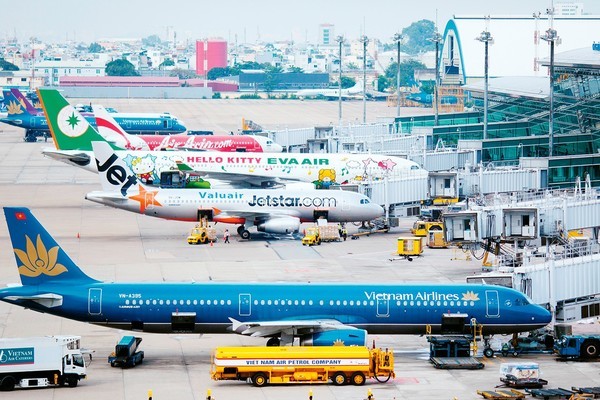Coordinating and sharing the use of infrastructure, premises, headquarters, working areas, and furniture at the airports in Vietnam
What are regulations on coordinating and sharing the use of infrastructure, premises, headquarters, working areas, and furniture at the airports in Vietnam? What are regulations on coordinating, sharing, using and operating systems, machinery and equipment for working and serving at the airports of Vietnam? What are regulations on coordinating in inspection and supervision at the airports of Vietnam?
Thank you!
What are regulations on coordinating and sharing the use of infrastructure, premises, headquarters, working areas, and furniture at the airports in Vietnam?
Pursuant to Article 9 of the Joint Circular 63/2016/TTLT-BTC-BGTVT stipulating the coordination in sharing and use of infrastructure, premises, headquarters, working areas, furniture and electricity and water systems, and communication networks and telecommunications at the airports as follows:
1. The Airport Authority shall assume the prime responsibility for and coordinate with the Director of the Airport in consulting the actual needs of the relevant Customs Sub-Department of the province or city to agree on how to share and use the premises, headquarters, working areas, interior layout and electricity and water systems, information and telecommunications networks in relevant areas in the following cases:
a) Develop technical and economic justification, ground design project, distribution, area;
b) Design changes during construction or completion of installation;
c) Unexpected changes (increase or decrease) due to the requirements of the professional work.
2. Allocation of premises, headquarters, working areas, interior arrangement, electricity and water systems, information and telecommunications networks in relevant areas must comply with the following factors:
a) Prescribe the general ratio suitable to the actual total area;
b) Requirements for professional work and professional processes;
c) Procedures for operation, maintenance and maintenance of the system of machinery and equipment in service of goods inspection and supervision;
d) Organizational payroll, working equipment;
dd) Ensure logic and science; do not cause overlapping, congestion; open and convenient for the specific operation of the airport.
What are regulations on coordinating, sharing, using and operating systems, machinery and equipment for working and serving at the airports of Vietnam?
Pursuant to Article 10 of the Joint Circular 63/2016/TTLT-BTC-BGTVT stipulating regulations on coordinating, sharing, using and operating systems, machinery and equipment for working and serving at the airports of Vietnam as follows:
1. The Director of the Airport Authority shall assume the prime responsibility and the Director of the Airport shall coordinate with the Director of the Customs Sub-Department to agree:
a) Location of installation of surveillance cameras, scanners and other machinery and equipment for inspection and supervision;
b) Regulations on general use and operation;
c) Responsibilities related to the administration of the scanner system, inspection and monitoring equipment;
d) Arrangement of human resources to work and work shifts together.
2. Principles of sharing, using and operating systems, machines and equipment for work and for inspection and supervision:
a) Comply with the law, customs professional requirements, cargo supervision process, aviation security and safety;
b) Comply with the process of operating and maintaining systems, machines and equipment;
c) Convenient, well-ventilated, convenient for manipulation and use; not cause congestion, duplication;
d) Saving cost in terms of time, human resources and actual space of each airport.
3. The surveillance camera system of the airport areas is designed and installed to ensure:
a) Optimal for the purpose of monitoring, monitoring the entire area and objects to be monitored; have technical features to meet the requirements of remote operation control, zoom in, zoom out, and save images according to business requirements; ensure against waste due to overlapping, duplication in design and installation;
b) Connecting with the Customs to serve the purpose of supervision at the international passenger terminal area, isolation area, apron area, terminal area and warehouse of exported and imported goods, the area of the island to receive and return luggage, the routes for transporting passengers, luggage and goods to and from the aircraft, the area of factories and warehouses for repair and maintenance of foreign aircraft;
c) Customs authorities can remotely control a number of surveillance cameras locally when necessary;
d) The installation of other equipment (such as billboards, etc) does not affect the supervision of Customs and airports.
4. Scanners for hand luggage and checked baggage of passengers in transit and exit:
a) The location of installing the scanners for hand luggage of passengers on exit or in transit at the exit and transit isolation areas;
b) The location of the check-in baggage scanner of exiting passengers is installed in the area behind the check-in baggage check-in area of airlines;
c) The location of the scanner must be convenient for passengers, comply with the aviation security and safety procedures and the customs authority, and be suitable for the actual ground area;
d) The Director of the Airport and the Director of the Customs Sub-Department agree to jointly use and operate the baggage scanners of passengers on exit or in transit to ensure:
d.1) Accomplish the screening objectives of aviation security and safety and inspection and supervision by the Customs;
d.2) The operating procedure, conveyor speed and image structure are in accordance with the technical standards of irradiation and image inspection skills of aviation security and safety officers and customs officers in charge of screening;
d.3) In case the customs officer or the aviation security officer operating the scanner detects suspicious signs in the luggage, each party shall perform according to its functions and duties and be under the supervision of the Customs when re-scanning the suspicious luggage;
d.4) Customs officers and aviation security officers may review and analyze or store scanned images according to the professional requirements of each party.
5. Export goods scanner:
a) The location of the export cargo scanner at the station area, the warehouse for export goods before entering the station, the warehouse of goods waiting for export;
b) The location of the scanner must be convenient for the aviation security and safety professional process and the customs authority and suitable for the actual area of the cargo depot;
c) The scanner must ensure clear image quality, have the function of magnifying and preserving images, in accordance with the requirements of professional supervision;
d) The Director of the International Airport and the Director of the Customs Sub-Department agree to cooperate in the joint operation of the export cargo scanner to ensure:
d.1) Accomplish the screening objectives of aviation security, safety and supervision of the Customs;
d.2) The operating procedure, conveyor speed and image structure are in accordance with the technical standards of irradiation and image inspection skills of aviation security and safety officers and customs officers in charge of screening;
d.3) In case the customs officer or the aviation security officer operating the scanner detects suspicious signs in the goods, each party shall perform their respective functions and duties and be under the supervision of the Customs when re-scanning the goods in question;
d.4) Arranging working desks and screening screens for customs officers;
d.5) Customs officers and aviation security officers can review and analyze or store scanned images due to professional requirements.
6. Imported goods scanner:
a) The location of the imported goods scanner for the purpose of customs control in the area where the imported goods are returned;
b) The director of the Sub-department of Customs must be responsible for allocating human resources and organizing the screening of imported goods to ensure strict compliance with regulations; does not cause congestion, meets the quality and standards of aviation services;
c) Airport enterprises are responsible for arranging space for customs authorities to install scanners for imported goods.
7. The Director of the Airport Authority and the Director of the Customs Sub-Department reach an agreement with the Airport Enterprise to arrange the premises for the installation of the radioactive detection system in accordance with the professional process of the Customs authority. mandarin; ensure security, safety and quality, standards of aviation services; no congestion.
8. The Director of the Airport and the Director of the Customs Sub-Department agree on the location to install drug detectors and other surveillance equipment and machinery in accordance with the law and the professional process of the Customs; ensure security, safety and quality, standards of aviation services; no congestion.
What are regulations on coordinating in inspection and supervision at the airports of Vietnam?
Pursuant to Clause 1 Article 11 of the Joint Circular 63/2016/TTLT-BTC-BGTVT stipulating as follows:
Based on the actual situation in the locality, task requirements and professional process, according to their functions and tasks, the Director of the Customs Sub-Department or the Director of the Airport Authority shall assume the prime responsibility for organizing coordination with the Director of the Airport Authority or the Director of the Airport or the Director of the Customs Sub-Department and other functional forces in the airport area to:
1. Develop annual coordination plan on control and supervision of international passenger terminal area, isolation area, aircraft apron area, terminal area, warehouse for export and import goods, the area of the island to receive and return luggage, the routes for transporting passengers, luggage and goods from the aircraft, the factory area, depot for repair and maintenance of foreign aircraft, fuel storage and supply area, ground service equipment area, service road. The plan includes the following:
a) Objectives and scope of coordination in inspection, supervision, detection, fight and prevention of violations of illegal cross-border transportation of goods, smuggling and commercial fraud; violations of aviation security and safety, environmental and community protection, prevention of environmental pollution in the area under management at international airports;
b) Measures to implement the Plan;
c) Allocatation of human resources, means and funding for implementation; ensure to take advantage of available equipment and means;
d) Assignment of specific responsibilities and tasks.
Best regards!











